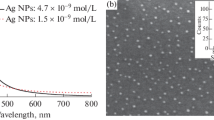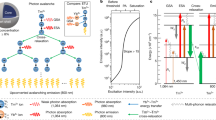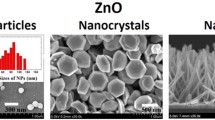Abstract
In this work, we present the experimental study of the nonlinear absorption of gold nanospheres and nanorods in aqueous suspension, using picosecond white-light supercontinuum open-aperture Z-scan. We demonstrate a saturable absorption effect in all particle suspensions at low-pulse energy. In the high-pulse energy regime, the apparent reverse-saturable absorption, observed in gold nanorods, was determined to be induced by photodegradation. Using the Lorentzian deconvolution method for the absorption spectra, we explain the variations on nonlinear optical effects and prove that saturable absorption only occurs within the plasmonic bands.
Similar content being viewed by others
Avoid common mistakes on your manuscript.
Introduction
During the last decade, nanotechnology has become one of the major driving forces for basic and applied research [1–3]. Matter at the nanoscale has been demonstrated to outperform in a wide variety of applications [4–7]. Metal nanoparticles, an important component of this promising field, have been successfully used in biological labeling and sensing [8–11], catalysis [12], surface-enhanced Raman scattering (SERS) [13], photonic [14], and optoelectronics [15]. Most of these applications are based on the well-known surface plasmon resonance (SPR) effect [16].
SPR in noble metal nanoparticles is manifested by well-defined absorption bands in the visible region [17], when the electrons in the conduction band interact with electromagnetic radiation. A remarkable feature of these bands is their dependence with the size and shape of the nanoparticles [18]. Additionally, the latter can produce a tremendous electric field enhancement at their surface [16]. Such an augmentation has been applied to second harmonic generation [19, 20], SERS [13], and multiphoton-assisted excitation and enhanced fluorescence of chromophores near metal surfaces [21–24]. Furthermore, it has been demonstrated that the radiative decay rate of molecules, placed in the close vicinity or attached to metal surfaces, can be modified by the presence of metal nanoparticles [25–27]. The interaction between nanoparticles and chromophores has lately awakened the interest of the scientific community to fully develop hybrid systems (metal–chromophores) with potential applications in the biomedical field, among others [25]. However, a better understanding of the physical, chemical, and optical properties of pure metal nanoparticles, which can affect the interaction metal–chromophores, is still in great need. Thus, it is necessary to exceed the current level of comprehension of the photophysical properties of pure nanoparticles by performing experiment through the whole SPR bands and in nanoparticles of different sizes, shapes, and compositions.
In an effort to gain insight on the optical properties of pure metal nanoparticles, Elim et al. [28] have recently studied the nonlinear absorption effects in these systems. Using discrete wavelengths, within a narrow spectral band, they observed induced bleaching in the plasmon absorption, i.e., saturable absorption. A similar type of behavior was previously observed by Link and El-Sayed [18] using transient absorption measurements pumping in the interband region. These authors demonstrated that the time of such a nonlinear optical process can be correlated with the electron–phonon (∼3 ps) and phonon–phonon (∼90 ps) relaxation processes.
In this work, we demonstrate broadband saturable absorption effects in gold nanospheres and nanorods with different aspect ratios within their corresponding full SPR bands. We show an enhanced saturable absorption effect in short aspect ratio nanorods in which the transversal and longitudinal SPR bands overlap. Besides, we show an apparent reverse-saturable absorption for input energies greater than 9 μJ and demonstrate that this effect is not inherently related to the plasmonic bands, but due to photodegradation of the nanoparticles. Experiments were performed using a white-light supercontinuum (SC) beam generated in water. The results obtained in this article demonstrate that pure gold nanoparticles could be used as saturable absorber for mode-locked lasers or materials for optical limiters in the high-intensity range.
Materials and methods
All reagents were purchased from Aldrich and used as received, unless otherwise stated. Gold (Au) nanospheres of approximately 16 nm average diameter (<20% size distribution) were synthesized according to the Turkevich method [29]. Briefly, 50 mL of preboiled 2.5 × 10−4 M chloroauric acid (HAuCl4, 99.999%) aqueous solution were mixed with 1.0 L of 3.4 × 10−3 M sodium citrate, Na3(C3H5O(COO)3), aqueous solution. The mixture was then heated and stirred for 5 min. The deep red color of the solution revealed the presence of gold nanoparticles. A typical SPR band, with maximum at approximately 530 nm, was observed using an Agilent 8453 spectrophotometer.
Au nanorods, of aspect ratio 2.2 and 2.4, length approximately 28 nm, and size distribution <15%, were synthesized using the modified seed-mediated growth method proposed by Pelton et al. [30] and described subsequently.
Preparation of the gold seed solution
One milliliter of a 0.1-M cetyltrimethylammonium bromide (CTAB, 95%) solution was mixed with 0.06 mL of 0.01 M sodium borohydride (NaBH4, >96%) and 0.025 mL of 10 mM HAuCl4. Afterward, the solution was heated to approximately 60 °C, while stirring it for 5 min. The change in color of the solution from tan to pink revealed the formation of the seeds.
Preparation of gold nanorod solutions
Ten milliliters of a 0.1-M CTAB solution were mixed with 0.5 mL of 0.01 M HAuCl4. Then, 0.05 and 0.1 mL of 10 mM silver nitrate (AgNO3, 99.9999%) were added for the subsequent formation of Au nanorods of aspect ratio 2.2 and 2.4, respectively. Afterward, 0.1 mL of 0.1 M l-ascorbic acid (reducing agent, 95%) was added followed by 0.2 mL of 0.1 M HCl (Fisher, Certified ACS Plus). The solution was then stirred until clear and heated to a temperature of 80 °C. Next, 0.05 mL of the seed solution was vigorously injected to the previous mixture and the resulting solution was heated for another 5 min. A blue–violet color indicated the presence of Au nanorods in solution. The typical longitudinal SPR bands of Au nanorods at 630 and 645 nm confirmed their aspect ratio [31]. The nanoparticles size distribution and shape were determined by transmission electron microscopy using an FEI Tecnai F30 TEM (images not included).
The nonlinear absorption spectra of gold nanoparticles, pumping within their linear absorption bands, were measured using a picosecond white-light supercontinuum Z-scan (SCZS; see Fig. 1) [32]. In our SCZS, a pulse of white-light SC, between 450 and 750 nm, was used to measure the nonlinear spectrum at all wavelengths simultaneously. To generate our SC, 25 ps (full width at half maximum) pulses from a Nd:YAG laser (1064 nm) working at a 10-Hz repetition rate, were focused with a 25-cm focal distance lens (L1) into a 10-cm path length cylindrical cell containing nanopure water. SC was stable (<10%) for average energies ranging from 5 to 40 μJ. Employing a low-pass infrared filter after the cell, the fundamental beam (pump) was separated from the SC, which was then collimated with a 10-cm focal distance achromatic convergent lens (L2). SC beam was then focused with lens L3 (f = 10 cm) into a 1-mm quartz cell (S) containing the nanoparticles suspension. Afterward, S was scanned along the z-direction by employing a stepper motor (SM), as in a traditional open-aperture Z-scan experiment [33]. To measure the open-aperture Z-scan, the beam transmitted trough the sample was completely focused, using a 25-cm focal distance achromatic lens (L4), into a 600-μm optical fiber plugged to a USB 2000 Ocean Optics spectrometer (∼2 nm spectral resolution). The small SC fluctuation was then reduced by taking 100 reading averages directly on the spectrometer. The typical SC spectrum is shown in the inset of Fig. 1.
We should highlight that the SC presents a temporal and spatial Gaussian distribution with a pulse width approximately 15 ps for all colors. The temporal width was characterized with the well-known optical Kerr effect using a strong pump pulse at 1,064 or 532 nm (second harmonic) from the Nd:YAG laser and a weak SC beam as a probe. The spatial distribution was determined by the optical fiber method [34] using a 50-μm optical fiber that was translated following the diameter of the collimated beam (different directions were measured) in the far field.
Results and discussion
The linear absorption spectra (open circles) of the Au nanospheres (a) and Au nanorods of two different aspect ratios, 2.2 (b) and 2.4 (c), in aqueous suspensions, are shown in Fig. 2. As expected, the plasmonic band for Au nanospheres is localized at approximately 2.35 eV and that for the transversal mode in Au nanorods placed at approximately the same energy. On the other hand, the SPR band corresponding to the longitudinal mode in nanorods appears at 2.00 and 1.93 eV for Fig. 2b and c, respectively. The difference in position of the longitudinal bands accurately respects its relationship with the nanorods aspect ratio [18, 31].
In order to separate the different contributions to the experimental spectra, we employed the deconvolution method [35] using Lorentz functions for the plasmonic components (blue and red lines) and an exponential decay for the interband transition region (violet line). The black solid line represents the theoretical spectrum resulting from the sum of all the deconvoluted functions. The theoretical fitting clearly matches the experimental spectra. Interesting to underline is the presence of a third Lorentzian band (green line) centered at approximately 3.1 eV in all three suspensions. Because this band is blue shifted with respect to the SPR band in Au nanospheres and the transversal SPR band in Au nanorods, it is not the outcome of interparticle plasmon coupling due to aggregation [36]. Therefore, we speculate that the origin of this band could be due to differences in the local dielectric constant in diverse metal nanoparticles resultant from the disparity in electron density at different sites. More work in this direction is in progress.
Figure 3 shows the normalized transmittance (NT; solid line) as a function of wavelength for the same gold nanoparticle suspensions. The plotted NT corresponds to the maximum value obtained at the focal plane in the Z-scan geometry. The increase in NT in all three nanoparticles suspensions reveals a saturable absorption effect within the SPR bands. One can notice that, for Au nanospheres, there is only one band centered at approximately the same wavelength as the SPR band. However, two bands can be observed in Au nanorods, which match the position of the SPR transversal and longitudinal modes. The saturable absorption effect in Au nanoparticles is the result of the saturation of the collective oscillation of electrons in the conduction band driven by the incoming electric field.
With the purpose of determining the nonlinear absorption coefficient, β, that describes the saturable absorption effect on gold nanoparticles of different shape and aspect ratio, we adjusted the Z-scan curves using Eq. 1 [38]:
being \(q_0 = I_0 \times \beta \times l \times {{w_0^2 } \mathord{\left/ {\vphantom {{w_0^2 } {w^2 }}} \right. \kern-\nulldelimiterspace} {w^2 }}\left( z \right)\). I 0 is the temporal profile of the pulse intensity (considered Gaussian), and l is sample thickness. w 0 and w(z) are the beam waist at focus and at any z-position, respectively. Figure 3 (right y-axis) displays the calculated β (solid circles) for all Au nanoparticles. As expected, the calculated values for β are negative, representing an increment in light transmission.
In Fig. 3 (right axis), it can be noticed that the nonlinear coefficients for Au nanospheres and the transversal mode of Au nanorods present very close values around −0.7 cm/GW. Yet, a small difference between the β measured on the transversal SPR band in nanorods of approximately 0.15 cm/GW is observed. We believe that this small difference is the result of the superposition between the transversal and longitudinal bands in the smaller aspect ratio gold nanorods, i.e., the saturable absorption signal is the additive outcome of the saturable absorption process for each mode. In the longitudinal modes, β presents a value close to −2.4 cm/GW for both nanorods, i.e., 3.6 times higher than the corresponding values for their respective transversal modes. This can be explained by considering that the number of electrons available on the longitudinal mode is greater than those on the transversal.
Interestingly, the saturable absorption effect in Au nanoparticles suspensions was found to have a dependence on the input energy of the SC. We have seen that NT increases up to 9 μJ. For energies greater than this value, the Z-scan signal gradually decreases in transmittance at the focal position. This behavior on the Z-scan signal could be originated by the presence of reverse-saturable absorption processes at high energies or caused by the change in shape and size of the original gold nanoparticles due to photodegradation. The latter was first confirmed by visual inspection of a cell containing freshly pumped nanoparticles solution. A change in color of the suspension from blue (nanorods) or red (nanospheres) to brownish indicated the photoinduced formation of nonhomogeneous Au particles by high-power radiation [37]. This observation results in a modification of the SPR bands in spheres and nanorods, as shown in Fig. 4a and b. The linear absorption spectra taken after irradiation with energies above 9 μJ (data not shown here) exhibited an increase of the transversal SPR band at the expense of a decrease in amplitude of the longitudinal SPR band in the nanorods. Furthermore, the transformation of Au nanoparticles was stronger at the focal plane of the focusing geometry used for the Z-scan measurement, i.e., at which the irradiance is the highest. These results are slightly different from those reported by Elim et al. [28] on reverse-saturable absorption in Au nanorods measured with femtosecond laser pulses. Perhaps, using femtosecond pulses, the possibility of photodegradation is less likely than with picoseconds.
Conclusion
We have demonstrated that the saturable absorption effect in Au nanoparticle suspensions (spheres and nanorods) is the outcome of the saturation of the collective oscillation of electrons in the conduction band. Also, we have determined that the apparent reverse-saturable absorption effects in gold nanoparticles, at high-input energies using picosecond pulses, is caused by the photodegradation of nanoparticles. Applications of these two effects in the design of nanoparticle-based optical switches in the low-energy regime and optical limiters in the high-energy range are anticipated.
References
He J, VanBrocklin HF, Franc BL, Seo Y, Jones EF (2008) Current Nanoscience 4:17–29
Bhushan B (2006) Springer handbook of nanotechnology. New York, Springer
Mohamadi MR, Mahmoudian L, Kaji N, Tokeshi M, Chuman H, Baba Y (2006) Nano Today 1:38–45
Yang WR, Thordarson P, Gooding JJ, Ringer SP, Braet F (2007) Nanotechnology 18:412001
Tenne R (2006) Nature Nanotechnology 1:103–111
Michalet X, Pinaud FF, Bentolila LA, Tsay JM, Doose S, Li JJ, Sundaresan G, Wu AM, Gambhir SS, Weiss S (2005) Science 307:538–544
Daniel MC, Astruc D (2004) Chem Rev 104:293–346
Nicewarner-Peña SR, Freeman RG, Reiss BD, He L, Peña DJ, Walton ID, Cromer R, Keating CD, Natan MJ (2001) Science 294:137–141
Bruchez M, Moronne M, Gin P, Weiss S, Alivisatos AP (1998) Science 281:2013–2016
Grate JW, Nelson DA, Skaggs R, Syvonec RE, Gross GM (2004) In encyclopedia of nanoscience and nanotechnology. Marcel Dekker, New York
Zhang J, Malicka J, Gryczynski I, Lakowicz JR (2004) Anal Biochem 330:81–86
Valden M, Lai X, Goodman DW (1998) Science 281:1647–1650
Nie SM, Emery SR (1997) Science 275:1102–1106
Maier SA, Brongersma ML, Kik PG, Meltzer S, Requicha AAG, Atwater HA (2001) Adv Mater 13:1501–1505
Wertheim GK, Dicenzo SB, Youngquist SE (1983) Phys Rev Lett 51:2310–2313
Raether H (1988) Surface plasmons on smooth and rough surfaces and gratings. Springer, New York
Kreibig U, Vollmer M (1995) Optical properties of metal clusters. Springer, Berlin
Link S, El-Sayed MA (1999) J Phys Chem B 103:8410–8426
Zavelani-Rossi M, Celebrano M, Biagioni P, Polli D, Finazzi M, Duo L, Cerullo G, Labardi M, Allegrini M, Grand J, Adam PM (2008) Appl Phys Lett 92:093119
Finazzi M, Biagioni P, Celebrano M, Duo L (2007) Phys Rev B 76:125414
Cohanoschi I, Hernandez FE (2005) J Phys Chem B 109:14506–14512
Shen YZ, Swiatkiewicz J, Lin TC, Markowicz P, Prasad PN (2002) J Phys Chem B 106:4040–4042
Kano H, Kawata S (1996) Opt Lett 21:1848–1850
Zhang YX, Aslan K, Previte MJR, Geddes CD (2007) Appl Phys Lett 90:053107
Hernández FE, Yu S, García M, Campiglia AD (2005) J Phys Chem B 109:9499–9504
Barnes WL (1998) J Mod Opt 45:661–699
Lakowicz JR, Shen YB, D’Auria S, Malicka J, Fang J, Gryczynski Z, Gryczynski I (2002) Anal Biochem 301:261–277
Elim HI, Yang J, Lee JY, Mi J, Ji W (2006) Appl Phys Lett 88:083107
Turkevich J, Stevenson PC, Hillier J (1951) Discuss Faraday Soc 11:55–59
Pelton M, Liu M, Kim HY, Smith G, Guyot-Sionnest P, Scherer NF (2006) Opt Lett 31:2075–2077
Link S, El-Sayed MA (2005) J Phys Chem B 109:10531–10532
De Boni L, Toro C, Hernandez FE (2008) Opt Express 16:957–964
Sheik-Bahae M, Said AA, Wei TH, Hagan DJ, Van Stryland EW (1990) IEEE J Quantum Electron 26:760–769
Sheu FW, Chang CH (2007) Am J Phys 75:956–959
Johnson PB, Christy RW (1972) Phys Rev B 6:4370–4379
Haes AJ, Zou SL, Zhao J, Schatz GC, Van Duyne RP (2006) J Am Chem Soc 128:10905–10914
Link S, El-Sayed MA (2001) J Chem Phys 114:2362–2368
Correa DS, De Boni L, Misoguti L, Cohanoschi I, Hernandez FE, Mendonca CR (2007) Opt Commun 277:440–445
Acknowledgments
This research was supported by startup funds provided to FEH by the Department of Chemistry, University of Central Florida. LDB would like to acknowledge CAPES (Brazil) for the financial support through project 4169/06-9.
Author information
Authors and Affiliations
Corresponding author
Rights and permissions
About this article
Cite this article
De Boni, L., Wood, E.L., Toro, C. et al. Optical Saturable Absorption in Gold Nanoparticles. Plasmonics 3, 171–176 (2008). https://doi.org/10.1007/s11468-008-9071-1
Received:
Accepted:
Published:
Issue Date:
DOI: https://doi.org/10.1007/s11468-008-9071-1








